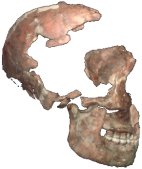The evolution of hominin dietary adaptations linked with environmental changes: extending the record beyond 100,000 years
Description
Hominin diets have changed through time, from a largely vegetarian adaptation to one where animal protein, mainly meat, became increasingly important.
Indeed some have argued that meat eating was a fundamental leap forward in human evolution, allowing our brains to expand more than other primates.
The evidence for these dietary changes are largely based on artefacts and hominid morphological changes, but these indirect methods of diet reconstruction only provide a partial picture of subsistence.
Stable isotope analysis of proteins (bone collagen) extracted from hominins such as Neanderthals and early modern humans has provided direct measures of past diets. But collagen does not survive much beyond 100 thousand years. Therefore, we cannot currently extend these measurements to earlier hominins to get a clearer picture of how diets changed through time, and if the remarkable changes in hominid brain size and cognition are indeed related to an increased consumption of meat.
Details
Project members
- Mike Richards
- Matthew Collins
Co-investigators and key collaborators
- Michale Rennie (Nottingham)
- Christina Nielsen-Marsh (Max Planck Institute for Evolutionary Anthropology, Leipzig)
- Erik Trinkaus (Washington University)
Project dates
- 2006-2009
Funding body
Objectives
- to develop methods to extract proteins from non-collagenous and longer surviving proteins from faunal and hominin samples from Europe, the Near East and Africa. These include, for example osteocalcin and enamel, which in some cases can survive up to a million years
- to extract and quantify these to ensure they were the original proteins and not contaminants, so that future isotopic work could be undertaken on them
Results
We succeeded in extracting and sequencing the protein osteocalcin from a Neanderthal from Shanidar Cave in Iraq, which was published in the journal PNAS. This individual did not have any preserved collagen, making traditional isotopic analysis impossible.

